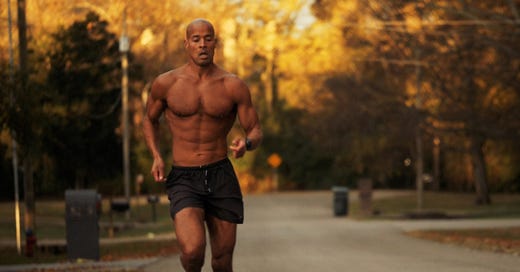Since I was a kid, I’ve loved exercise.
The process was enthralling. Blood filling my muscles, sweat stinging my eyes, the knurled metal bar tearing the hardened skin off my calluses. And I couldn’t resist coming back for the feeling of progress, of inching closer to my aspirations.
But this year, exercise has felt like a chore.
I check my phone like a train conductor on a tight schedule as the clock inches closer to 6:45 a.m. I feel antsy. My sacred reading and coffee time is nearly up which means I’m moving into the second part of my morning: the workout.
My legs feel heavy and grip weak. The cold weights seem to have doubled in heaviness since I last touched them. My body was starting its exercise routine, but my heart had crawled back into bed.
I lost my burning enthusiasm for the thing I loved most.
To make sense of where I went wrong, I had to rewind fifteen years to when my passion for exercise was first ignited.
Where My Love for Exercise Began
Over the years, my dad had piecemealed our dusty garage into a gym.
Men’s Health Magazines scattered across the paint-splattered wooden workbench, a stationary bike in the corner, dumbbells and medicine balls lined along the ground below where our hockey equipment hung to dry, a heavily duct-taped pull-up bar hooked under the door frame.
I was only nine or ten, but I knew — without words or feelings to explain it — that I wanted to go into that garage and lift stuff. I wanted to thumb through the magazines and follow the workouts my dad followed. I wanted my sweat to pool on the floor around the stationary bike.
Like a cub learning to catch salmon from the stream, I was imitating my dad. I watched, I trusted, I learned. I saw a future for myself in my dad. A glimpse of a stronger, fitter me. Inspired by my desire to be like him and armed with his approach to exercise, I had all I needed to start working out.
For me, exercise was always spiritual as much as it was physical.
I was following my intuition, testing my limits, and uncovering my identity on a journey of transformation, of becoming. It felt natural. Exciting. Fun.
By choosing a role model, I could adopt their best practices and mentality while holding an image in my mind of who I would become if I persisted long enough.
I swung kettlebells with the precise aggression of SEAL instructor and elite performance coach Pavel Tsatsouline, hammered long runs with the grit of Goggins, lengthened my hamstrings with the suppleness of yoga instructor Rodney Yee, and grinded out tough workouts with the inexhaustible relent of my dad.
Although my role models changed over the years, I invariably organized my exercise around someone I admired.
Up until now.
Before this year, my exercise routine was inspired by people. I imitated them because their approach to fitness spoke to my soul. They were driven by emotion and their purpose was far beyond exercise-induced physical adaptations. My workouts were powered by the story of their lives and the authenticity of their identities.
I intuitively knew then what I consciously know now:
Exercise should be an imitative act.
The Current State of Exercise
But exercise is becoming emotionally sterilized and entirely science and data-driven.
And this year, I bought in.
I opted for cold hard science delivered prescriptively in podcasts. I revamped my exercise routine based on optimal protocols from scientific studies rubber-stamped by doctors and PhDs.
I tried to replicate study results to improve uninspiring and intangible targets like my VO2 max, appendicular lean mass (ALM), and mitochondrial efficiency.
Science screamed metrics, thresholds, tests, and insufficiency — whenever I started to feel like I was fit enough, I stumbled across a new test, a higher standard to hold myself to.
Regardless of what my workouts consisted of, buying into the science robbed me of the beautiful suffering exercise used to provide me. I lost touch with my intuition. I was no longer testing my spirit, overcoming a challenge, or embarking on a journey to become like those who inspire me.
I was simply trying to meet a metric so, according to a study, I might live longer.
On those dark mornings when the weights were heavy and my resolution felt soft, I had nothing but sheer will to force myself through the workout. I got it done but I dreaded it.
My scientifically optimized program didn’t grip my spirit or excite me. My passion for exercise and the joy it once gave me had slipped away like the foggy memory of a past life.
My Path Forward
For now, I’m done with over prescriptive study-informed workouts that suck the joy out of exercise. I’m pressing pause on the PhD podcasts and fighting to drop the optimization mindset I’ve fallen into this year.
I’m relearning to buy into the stories of souls who light me on fire and imitating the people who breathe life and emotion into exercise.
And for the first time this year, I’m excited to exercise again.





Yes! I listened to David Goggins' book "Can't Hurt Me" on audiobook this summer while doing my cycling over the summer, and I swear I rode 2 X far as I thought I could each day while I had Goggins's story in my ear, inspiring me on.
This is so relatable Jack. I definitely got caught in the trap of trying to optimize too much for Zone 2, sometimes going to a Stairmaster instead of a hike.
Exercise has felt more a chore for me lately! Maybe that’s because it’s solo and not with teammates or other people, but either way: if my Zone 2 metrics suffer for me to go hiking, it’s so worth it.